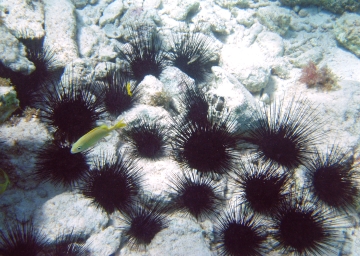750625_Out of Balance_360 px width.jpg

Long-spined sea urchins play a key role in keeping algae off of coral reefs in the Caribbean. Disease and parasite have dwindled their population in recent decades. Credit: James St. John, CC BY 2.0
Depending on which side of the country you live on, you probably either hate or love sea urchins. Off the coast of California, there are too many of the spiny creatures. They’re destroying kelp beds, harming the entire ecosystem.
But off the coast of Florida—and throughout the Caribbean Sea—there aren’t enough urchins. And without them, coral reefs are dying off.
Long-spined sea urchins used to be common in the Caribbean. They have black spines that can be up to a foot long. And their “teeth” are rocky plates that allow them to scrape algae from corals and other hard surfaces.
In 1983, a disease raced across the Caribbean. Within two weeks, it had killed 97 percent of the urchins. And in 2022, a parasite hit the still-recovering urchin population, wiping out most of the urchins on most reefs.
Without the urchins, the algae population has exploded. Algae can cover the corals, blocking the sunlight the living corals need to survive. The algae also coat the surfaces that young corals latch themselves to, preventing them from establishing new colonies.
Combined with climate change, ocean pollution, and other problems, that’s cut the amount of corals across the Caribbean by about 80 percent since the 1970s.
Today, scientists are raising urchins in the lab, then dropping them on reefs. It’s too early to tell how that’s working out. But researchers are hopeful that the efforts will begin to restore balance to Caribbean reefs.

